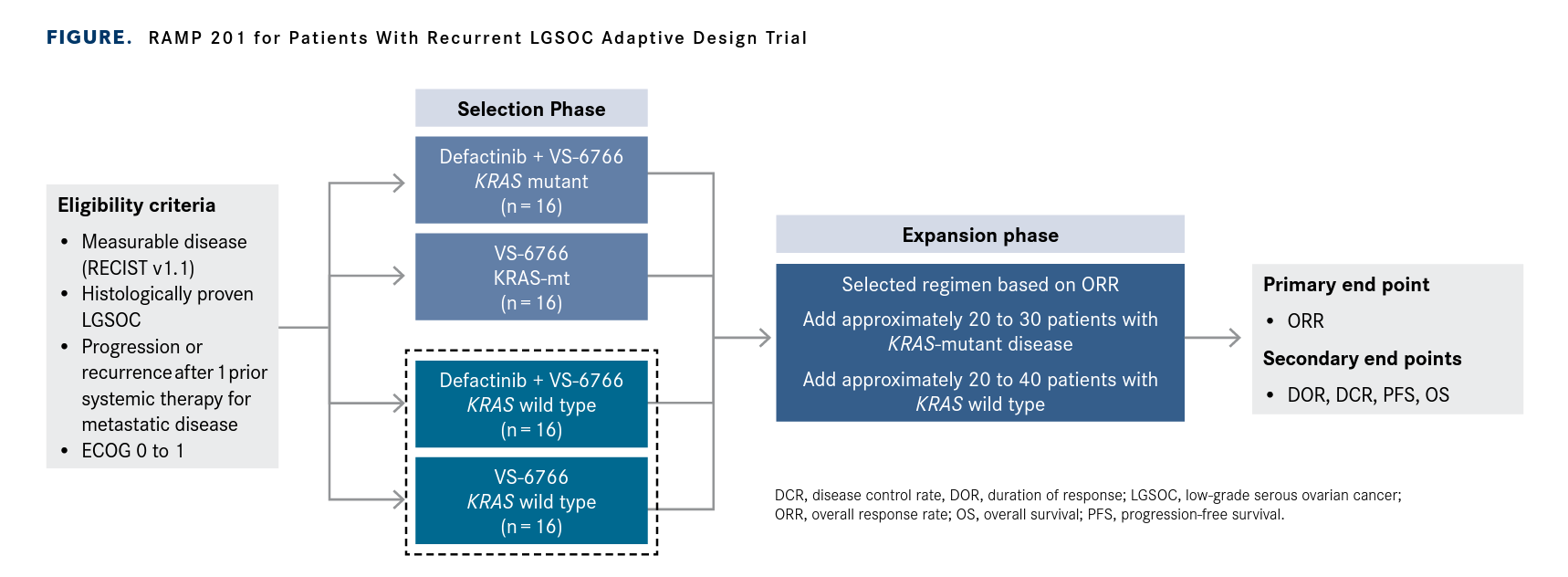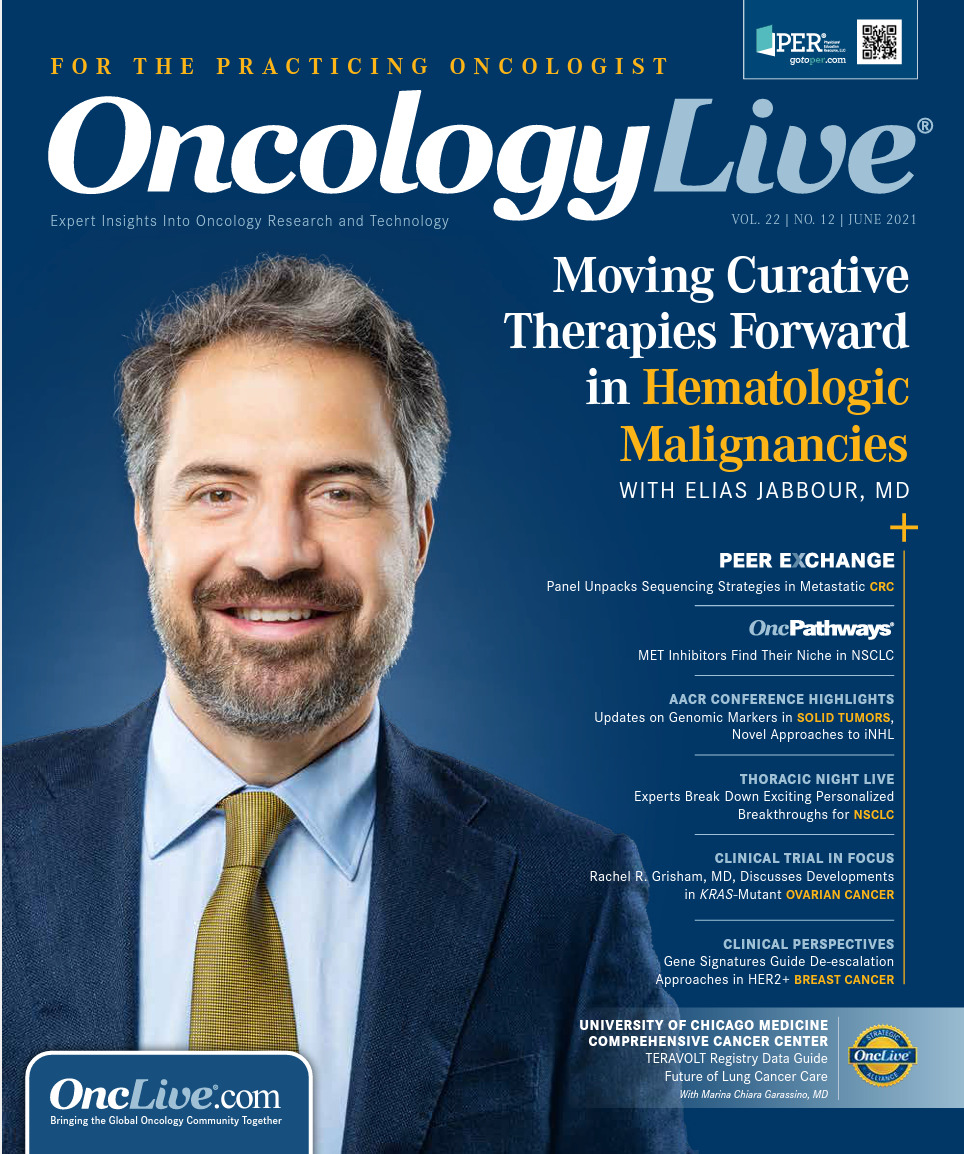Publication
Article
Oncology Live®
KRAS Pathway Opens Door for Patients With Difficult-to-Treat Ovarian Cancer
Author(s):
Dual blockade of the RAF/MEK and FAK pathways presents an opportunity for investigators to enhance and expand the number of patients with recurrent low-grade serous ovarian cancer who can benefit from targeted therapies.
Rachel N. Grisham, MD

Dual blockade of the RAF/MEK and FAK pathways presents an opportunity for investigators to enhance and expand the number of patients with recurrent low-grade serous ovarian cancer (LGSOC) who can benefit from targeted therapies. LGSOC, which accounts for between 1.02% and 3.64% of all ovarian carcinomas and 4.66% of serous ovarian carcinomas1, is molecularly unique from high-grade serous ovarian cancer (HGSOC) with approximately 70% of patients harboring a RAS pathway- associated mutation: approximately 30% have KRAS-mutant disease; 20% have NRAS-, BRAF-, or ARAF-mutant disease; and 20% have other RAS-associated gene mutations.2,3
Investigators are seeking to capitalize on the proficiency of this target in the phase 2 RAMP 201 study (NCT04625270), which will evaluate the dual RAF/MEK inhibitor VS-6766 alone and in combination with the FAK/PYK2 inhibitor defactinib.
LGSOC has a distinct molecular profile, explained Rachel N. Grisham, MD, in an interview. “Patients with low-grade serous ovarian cancer are more likely to have alterations affecting the MAP kinase pathway, and the most frequent alternation that we see in these patients is KRAS mutation. Prior studies looking at single-agent MEK inhibitors have shown promising response rates as high as 25%,” she said, adding that VS-6766 aims to provide a deeper and more sustained response. Grisham serves as section head of ovarian cancer and director of gynecologic medical oncology at Memorial Sloan Kettering Cancer Center, in New York, New York.
A PATH FORWARD
LGSOC is less biologically aggressive compared with HGSOC and has a lower sensitivity to chemotherapy. Treatment options for patients with LGSOC have been limited and recommended first line therapies include platinum chemotherapy combinations or treatment with aromatase inhibitors such as anastrozole or letrozole.4 Options for patients who experience disease recurrence are limited to rechallenge with chemotherapy, or trametinib (Mekinist)or fulvestrant (Faslodex).
Response rates, however, are limited with less than 10% of patients treated with chemotherapy experiencing a response, 14% with letrozole. Despite 25% of patients achieving a response with trametinib, approximately 31% to 35% of patients discontinue treatment with MEK inhibitors because of adverse effects (AEs).3
LGSOC is less aggressive biologically compared with HGSOC and typically presents without p53 mutations or homologous recombination deficiency, Grisham explained. “In patients with HGSOC, these alterations allow for platinum-based chemotherapy and PARP inhibitors to work well,” she said.
The dual inhibitory mechanism of action of VS-6766 blocks MEK kinase activity as well as RAF phosphorylation of MEK, which results in the blockade of the RAS pathway, thus limiting compensatory MEK activation.3,5 Further, this allows the agent to more completely inhibit ERK signaling and confers enhanced therapeutic activity; however, following this inhibition there is a compensatory increase in FAK signaling. Investigators hypothesized that adding defactinib would result in more effective inhibition of downstream signaling pathway.5 “By combining a FAK inhibitor with the dual MEK and RAF inhibitor, we hope that these tumor cells will not develop resistance to MEK/RAF inhibitors,” Grisham said.
In results from a subgroup of patients with refractory LGSOC (n = 21) from the phase 1 FRAME trial (NCT03875820) the combination elicited an overall response rate (ORR) of 52%. The response was improved among patients with KRAS mutations (n = 10) with an ORR of 70% compared with 44% (n = 4/9) in patients with KRAS wild-type disease.5
Based on these data, the FDA granted breakthrough therapy designation for the combination of VS-6766 and defactinib to treat patients with recurrent LGSOC regardless of KRAS status after at least 1 prior line of therapy.6
AN UNMET NEED IN OVARIAN CANCER
Building on early efficacy data for this patient population, RAMP 201 is an adaptive, 2-part, randomized, open-label trial to evaluate the efficacy and safety of VS-6766 alone and in combination with defactinib in patients with recurrent LGSOC with or without a KRAS mutation.7
The first part of the study will determine the optimal regimen of either VS-6766 monotherapy or VS-6766 in combination with defactinib. Patients with recurrent LGSOC will be randomized 1:1 in each treatment arm (FIGURE7).
Investigators are enrolling between 104 to 134 total patients; 64 patients will be enrolled will be enrolled to the first part of the study. The expansion phase will add between 20 and 30 patients with KRAS mutations and between 20 and 40 patients without KRAS mutations.
Patients will be randomized to receive VS-6766 4.0 mg orally, twice weekly for 3 weeks and then 1 week off or VS6766 2 mg orally, twice weekly along with defactinib 3.2 mg orally twice a day for 3 weeks and then 1 week off until progression.2,7 Secondary end points include ORR, duration of response, disease control rate, progression-free survival, and overall survival.
Investigators will determine the parameters of the expansion phase of the trial based on ORR data and will evaluate efficacy and safety parameters of the regimen selected.
“This is an innovative design to get the results that we need as quickly as possible for this patient population,” Grisham said. “If the combination is more effective, but considerably more toxic, then we may not go forward with the combination. If it doesn’t seem as though the FAK inhibitor is adding to the efficacy, then we would go forward with just the single agent, the dual MEK/RAF inhibitor.”
Grisham noted that recruitment has been faster than expected in the months since the study opened. “We expect that to increase as we open more sites both across the United States and soon in Europe. 30% KRAS mutant 20% NRAS, BRAF, ARAF mutant. Hopefully, if we continue at this pace, the study will be complete in less than 2 years,” she said.
Verastem Oncology, the developer of both VS-6766 and defactinib, plan to use data from RAMP 201 to support an accelerated approval of the combination.3
FIGURE. RAMP 201 for Patients With Recurrent LGSOC Adaptive Design Trial

ONGOING RESEARCH
In addition to patients with LGSOC, the FRAME study has enrolled patients with KRAS-mutant non–small cell lung cancer (NSCLC), KRAS G12V–mutant NSCLC, pancreatic cancer, colorectal cancer, and KRAS-mutant endometrioid cancer.3 At the American Association for Cancer Research Virtual Annual Meeting 2021, clinical activity was reported in patients with KRAS-mutant NSCLC (n = 20) who were included in the FRAME trial.6 Patients had a median of 3 prior lines of treatment (range, 1-5). With a data cutoff of March 5, 2021, the ORR was 15% and the disease control rate was 65%. Of note, investigators reported an ORR of 100% in the 2 patients with KRAS G12V mutations. Further analysis showed a median progression-free survival of 16 weeks and 7 patients remaining on treatment at least 24 weeks.6 The phase 1b/2 RAMP 202 trial (NCT04620330) was initiated to evaluate the combination in patients with NSCLC with recurrent G12V or other KRAS mutations.8 The trial will measure effectiveness, including ORR, and safety of the combination vs VS-6766 alone.
FIGURE. KRAS Mutation Rates in LGSOC Patient Population

Outside of the FRAME trial, investigators are evaluating the dual inhibitor therapy for the treatment of patients with metastatic uveal melanoma in a phase 2 study (NCT04720417).
“For decades, LGSOC has been a disease that, unfortunately, is less responsive to chemotherapy but that was the option that we had. Now we have these studies looking at exciting new drug combinations that hopefully will be giving us really impressive and sustainable response rates,” Grisham said.
References
- Gadducci A, Cosio S. Therapeutic approach to low-grade serous ovarian carcinoma: state of art and perspectives of clinical research. Cancers (Basel). 2020;12(5):1336. doi:10.3390/cancers12051336
- Banerjee SN, Monk BJ, Van Nieuwenhuysen E, et al. ENGOT-ov60/GOG3052/RAMP 201: a phase 2 study of VS-6766 (dual RAF/MEK inhibitor) alone and in combination with defactinib (FAK inhibitor) in recurrent low-grade serous ovarian cancer (LGSOC). J Clin Oncol. 2021;39(suppl 15):TPS5603. doi:10.1200/JCO.2021.39.15_suppl.TPS5603
- Corporate presentation. Verastem Oncology. May 2021. Accessed June 8, 2021. https://investor.verastem.com/static-files/0dec46c2-5d9e-406b-958e-4225eab078c2
- NCCN. Clinical Practice Guidelines in Oncology. Ovarian cancer including fallopian tube cancer and primary peritoneal cancer, version 1.2021. Accessed June 8, 2021. https://www.nccn.org/professionals/physician_gls/pdf/ovarian.pdf
- Krebs MG, Shinde R, Rahman RA, et al. FRAME: a phase I trial of the combination of the dual RAF-MEK inhibitor VS-6766 and the FAK inhibitor defactinib; evaluation of efficacy in KRAS mutated NSCLC. Presented at: American Association for Cancer Research Annual Meeting 2021; April 10-15, 2021; virtual. Abstract 1425. Accessed June 8, 2021. https://www.verastem.com/wp-content/uploads/2021/04/AACR-2021-FRAME-slides-final-presented.pdf
- Verastem Oncology receives breakthrough therapy designation for VS-6766 with defactinib in recurrent low-grade serous ovarian cancer. News release. Verastem Oncology. May 24, 2021. Accessed June 8, 2021. https://investor.verastem.com/news-releases/news-release-details/verastem-oncology-receives-breakthrough-therapy-designation-vs
- A study of VS-6766 v. VS-6766 + defactinib in recurrent low-grade serous ovarian cancer with and without a KRAS mutation. ClinicalTrials.gov. Updated June 8, 2021. Accessed June 8, 2021. https://www.clinicaltrials.gov/ct2/show/NCT04625270
- A study of VS-6766 v. VS-6766 + defactinib in recurrent G12V or other KRAS-mutant non-small cell lung cancer. ClinicalTrials.gov. Updated June 2, 2021. Accessed June 3, 2021. https://clinicaltrials.gov/ct2/show/NCT04620330








%20u.jpg?fit=crop&auto=format)

